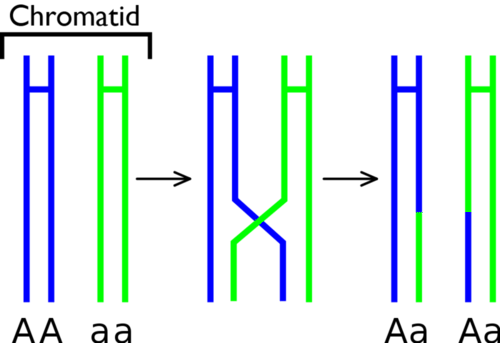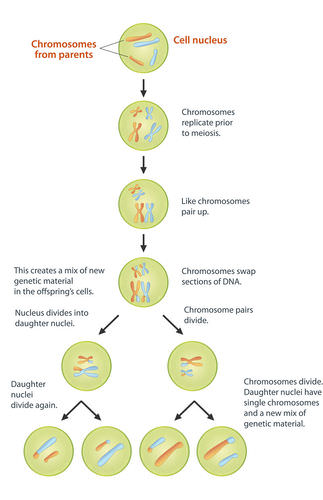2.23减数分裂
章节大纲
-
Do you have ALL your parents' chromosomes ?
::你有你父母的所有染色体吗?No, you only received half of your mother's chromosomes and half of your father's chromosomes. If you inherited them all, you would have twice the number of chromosomes that you're supposed to have. Humans typically have 23 pairs of chromosomes. If you received all your parents' chromosomes, you would have 46 pairs!
::不,你只收到你母亲一半的染色体和你父亲一半的染色体。如果你全部继承,你会有两倍的染色体。人类通常有23对染色体。如果你收到你父母所有染色体,你会有46对!Introduction to Meiosis
::Meisisic介绍介绍Sexual reproduction combines gametes from two parents. Gametes are reproductive cells , such as and egg . As gametes are produced, the number of chromosomes must be reduced by half. Why? The zygote must contain genetic information from the mother and from the father, so the gametes must contain half of the chromosomes found in normal body cells. When two gametes come together at , the normal amount of chromosomes results. Gametes are produced by a special type of known as meiosis . Meiosis contains two rounds of cell division without DNA replication in between. This process reduces the number of chromosomes by half.
::双亲的性生殖组合。 双胞胎是生殖细胞, 如和蛋。 当生成调子时, 染色体的数量必须减少一半 。 为什么? zygote 必须包含来自母亲和父亲的遗传信息, 所以调子必须包含在正常身体细胞中发现的一半染色体。 当两个调子聚集在一起时, 染色体的正常数量产生结果 。 调子是由一种特殊类型, 叫做美容。 Meisis 包含两轮细胞分解, 而不同时复制DNA 。 这个过程会将染色体的数量减少一半 。Human cells have 23 pairs of chromosomes, and each chromosome within a pair is called a homologous chromosome . For each of the 23 chromosome pairs, you received one chromosome from your father and one chromosome from your mother. Alleles are alternate forms of genes found on chromosomes. Homologous chromosomes have the same genes, though they may have different alleles. So, though homologous chromosomes are very similar, they are not identical. The homologous chromosomes are separated when gametes are formed. Therefore, gametes have only 23 chromosomes, not 23 pairs.
::人类细胞有23对染色体,一对中的每一对染色体被称为同质染色体。对于23对染色体中的每一对,你从父亲那里得到了一个染色体,从母亲那里得到了一个染色体。异性体是染色体上发现的基因的替代形式。同性染色体有相同的基因,尽管它们可能有不同的异性。因此,尽管同性染色体非常相似,但它们并不相同。在形成调色体时,同性染色体是分开的。因此,同性体只有23个染色体,而不是23对。Haploid vs. Diploid
::标本与标本A cell with two sets of chromosomes is diploid , referred to as 2n , where n is the number of sets of chromosomes. Most of the cells in a are diploid. A cell with one set of chromosomes, such as a gamete, is haploid , referred to as n . Sex cells are haploid. When a haploid sperm ( n ) and a haploid egg ( n ) combine, a diploid zygote will be formed ( 2n ). In short, when a diploid zygote is formed, half of the comes from each parent.
::含有两组染色体的细胞是低血球,称为2n,其中n为染色体组数。一个细胞中的大多数是低血球。一个细胞有一套染色体,例如调色板,是一个杂交细胞,称为n。性细胞是杂交的。当杂交精子和杂交蛋
结合时,将形成一个diploid zygote
。简而言之,当形成潮湿的zygote(diploid zygote)时,一半来自父母。
Overview of Meiosis
::Meisisic 概览Before meiosis begins, DNA replication occurs, so each chromosome contains two sister chromatids that are identical to the original chromosome. Meiosis ( Figure ) is divided into two divisions: Meiosis I and Meiosis II. Each division can be divided into the same phases: prophase , metaphase , anaphase , and telophase . Cytokinesis follows telophase each time. Between the two cell divisions, DNA replication does not occur. Through this process, one diploid cell will divide into four haploid cells.
::在梅氏病开始之前,就出现了DNA复制,因此每个染色体都含有两个与原染色体相同的姐妹染色体。 Meisis(图)分为两个部分: Meisis I 和 Meisisis II。每个部分可以分为相同的阶段: 预期、 元阶段、 周期和调频阶段。 相形之下, 相形之下, 相形之下, 相形之下, 两种细胞之间不会出现DNA复制。 通过这个过程, 一个浸泡细胞将分成四个散状细胞 。Overview of Meiosis. During meiosis, four haploid cells are created from one diploid parent cell.
::Meisisis 概览: 在Meiosis 期间,从一个浸泡母细胞中创建了4个散状细胞。Meiosis I
::诊断一During meiosis I, the pairs of homologous chromosomes are separated from each other. This requires that they line up in their homologous pairs during metaphase I. The steps are outlined below:
::在甲状腺硬化一期期间,将同族染色体分开。这要求在元阶段一期间,将同族染色体排在同族染色体中。 步骤概述如下:- Prophase I: The homologous chromosomes line up together. During this time, a process that only happens in meiosis can occur. This process is called crossing over ( Figure ), which is the exchange of DNA between homologous chromosomes. Crossing over forms new combinations of alleles on the resulting chromosome. Without crossing over, the offspring would always inherit all of the alleles on one of the homologous chromosomes. Also during prophase I, the spindle forms, the chromosomes condense as they coil up tightly, and the nuclear envelope disappears.
::预期期一:同族染色体排列在一起。 在这段时间里, 只有在 meimosis 中才会发生一个过程。 这个过程叫做交叉( 图表 ) , 也就是同族染色体之间交换DNA 。 在由此产生的染色体上交叉异系新组合的形式。 不交叉, 后代将永远继承同族染色体之一的所有异系物。 在前期一, 螺旋形形式, 紧紧的圈子凝结的染色体, 以及核封消失 。
- Metaphase I: The homologous chromosomes line up in their pairs in the middle of the cell. Chromosomes from the mother or from the father can each attach to either side of the spindle. Their attachment is random, so all of the chromosomes from the mother or father do not end up in the same gamete. The gamete will contain some chromosomes from the mother and some chromosomes from the father.
::元件一:同族染色体排在细胞中间的对子中。来自母亲或父亲的染色体都可以附着在脊椎的两侧。他们的附着是随机的,因此所有来自母亲或父亲的染色体都不会最后出现在同一个调子中。游戏将包含来自母亲的一些染色体和来自父亲的一些染色体。
- Anaphase I: The homologous chromosomes are separated as the spindle shortens, and begin to move to opposite sides (opposite poles) of the cell.
::分析阶段一:单色染色体随着螺旋缩短而分离,开始向细胞的对面(对面杆)移动。
- Telophase I: The spindle fibers dissolves, but a new nuclear envelope does not need to form. This is because, after cytokinesis, the will immediately begin to divide again. No DNA replication occurs between meiosis I and meiosis II because the chromosomes are already duplicated. After cytokinesis, two haploid cells result, each with chromosomes made of sister chromatids.
::Telotal阶段一:脊椎纤维溶解,但不需要形成一个新的核封套。这是因为,在细胞基内斯后,将立即开始分裂。由于染色体已经重复,所以Meisisi I和Miosis II之间没有DNA复制,因为染色体已经重复了。在细胞基内斯后,2个破碎细胞的结果,每个细胞都有姐妹染色体组成的染色体。
Since the separation of chromosomes into gametes is random during meiosis I, this process results in different combinations of chromosomes (and alleles) in each gamete. With 23 pairs of chromosomes, there is a possibility of over 8 million different combinations of chromosomes (2 23 ) in a human gamete.
::由于染色体分离成配色体在美化一期间是随机的,这一过程导致每个调色体的染色体(和异形)的不同组合。 在23对染色体中,人类调色体中可能有800多万种染色体(223)的不同组合。During crossing over, segments of DNA are exchanged between non-sister chromatids of homologous chromosomes. Notice how this can result in an allele (A) on one chromatid being moved onto the other non-sister chromatid.
::在交叉过程中,DNA的分块在同族染色体的非姐妹染色体之间进行交换,注意这如何能导致一个染色体上的异性(A)被移到另一个非姐妹染色体上。Meiosis II
::诊断二During meiosis II, the sister chromatids are separated and the gametes are generated. This cell division is similar to that of , but results in four genetically unique haploid cells. The steps are outlined below:
::在二度中,姊妹染色体被分离并产生调色板。 这个细胞分裂与...相似, 但导致四个基因上独特的杂交细胞。 步骤概述如下:- Prophase II: The chromosomes condense.
::第二阶段:染色体凝结
- Metaphase II: The chromosomes line up one on top of each other along the middle of the cell, similar to how they line up in mitosis. The spindle is attached to the centromere of each chromosome.
::第二个元阶段:染色体在细胞中间的相互上排成一列,类似于它们排成一列时的线状。脊椎附在每一个染色体的丙红素上。
- Anaphase II: The sister chromatids separate as the spindle shortens and move to opposite ends of the cell.
::分析阶段二:姐妹染色体随着脊椎缩短而分离,移动到细胞的对面。
- Telophase II: A nuclear envelope forms around the chromosomes in all four cells. This is followed by cytokinesis.
::电波二:四个细胞的染色体周围都有一个核封套,然后是细胞基尼。
After cytokinesis, each cell has divided again. Therefore, meiosis results in four haploid genetically unique daughter cells , each with half the DNA of the parent cell ( Figure ). In human cells, the parent cell has 46 chromosomes (23 pairs), so the cells produced by meiosis have 23 chromosomes. These cells will become gametes.
::细胞基质后, 每一个细胞都再次分裂。 因此, 肾上腺硬化导致四个遗传基因上独特的女儿细胞, 每个细胞都有父细胞的DNA的一半( 图表 ) 。 在人体细胞中, 母细胞有46种染色体( 23对 ) , 因此, 由细胞细胞组成的细胞有 23 种染色体。 这些细胞将变成调子 。An overview of meiosis.
::肾上腺素综合症概览。Summary
::摘要- Meiosis is a process of cell division that reduces the chromosome number by half and produces sex cells, or gametes.
::Meisisis 是一个细胞分裂的过程 将染色体数量减少一半 产生性细胞, 或调子。
- Meiosis is divided into two parts: Meiosis I and Meiosis II. Each part is similar to mitosis and can be divided into the same phases: prophase, metaphase, anaphase, and telophase.
::Meisisis分为两部分: Meisisis I和 Meisisis II。 每一部分与Misosis相似,可分为相同的阶段:前期、前期、后期、后期和调频。
- Crossing over occurs only during prophase I.
::只有在第一阶段期间才发生跨越边界的情况。
- Four genetically unique haploid cells result from meiosis.
::四个基因上独一无二的杂交细胞 源自于肾上腺素综合症
Explore More
::探索更多Use the resource below to answer the questions that follow.
::利用以下资源回答以下问题。- Meiosis on YouTube at (9:15)
::在YouTube上(9:15)的 Meisisdo(9:15)
- What is meiosis?
::什么是肾上腺素?
- What is diploid? How many chromosomes are in a diploid human cell?
::什么是低血球?人类细胞中有多少染色体?
- What is a zygote? How does the zygote form the organism?
::什么是zygote?zygote是如何形成生物体的?
- What is the result of crossing over?
::跨越边界的结果是什么?
- How many cell divisions occur during meiosis?
::有多少细胞分解在诊断期间发生?
- Why are you genetically distinct?
::你为什么在基因上与众不同?
Review
::回顾- Define meiosis.
::确定线性硬化症的定义。
- What is the difference between a haploid cell and a diploid cell?
::折叠单元格和折叠单元格有什么区别?
- Describe the steps of Meiosis I and Meiosis II.
::描述Meisisi I 和 Meisisi II 的步骤。
- Describe crossing over. When does crossing over occur?
::过境情况说明:何时过境?
- What is the outcome of meiosis?
::抑郁症的结果是什么?
- Prophase I: The homologous chromosomes line up together. During this time, a process that only happens in meiosis can occur. This process is called crossing over ( Figure ), which is the exchange of DNA between homologous chromosomes. Crossing over forms new combinations of alleles on the resulting chromosome. Without crossing over, the offspring would always inherit all of the alleles on one of the homologous chromosomes. Also during prophase I, the spindle forms, the chromosomes condense as they coil up tightly, and the nuclear envelope disappears.



